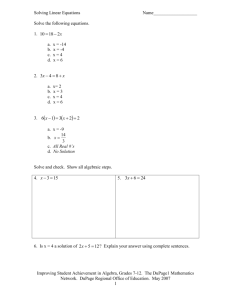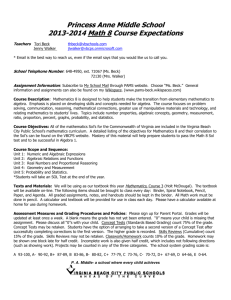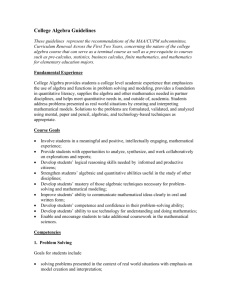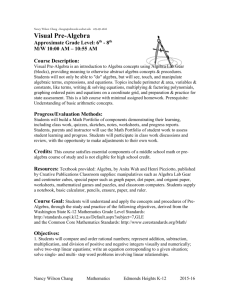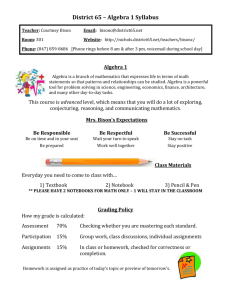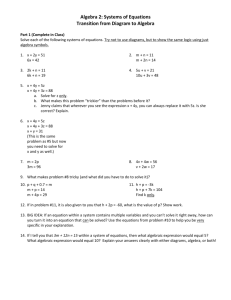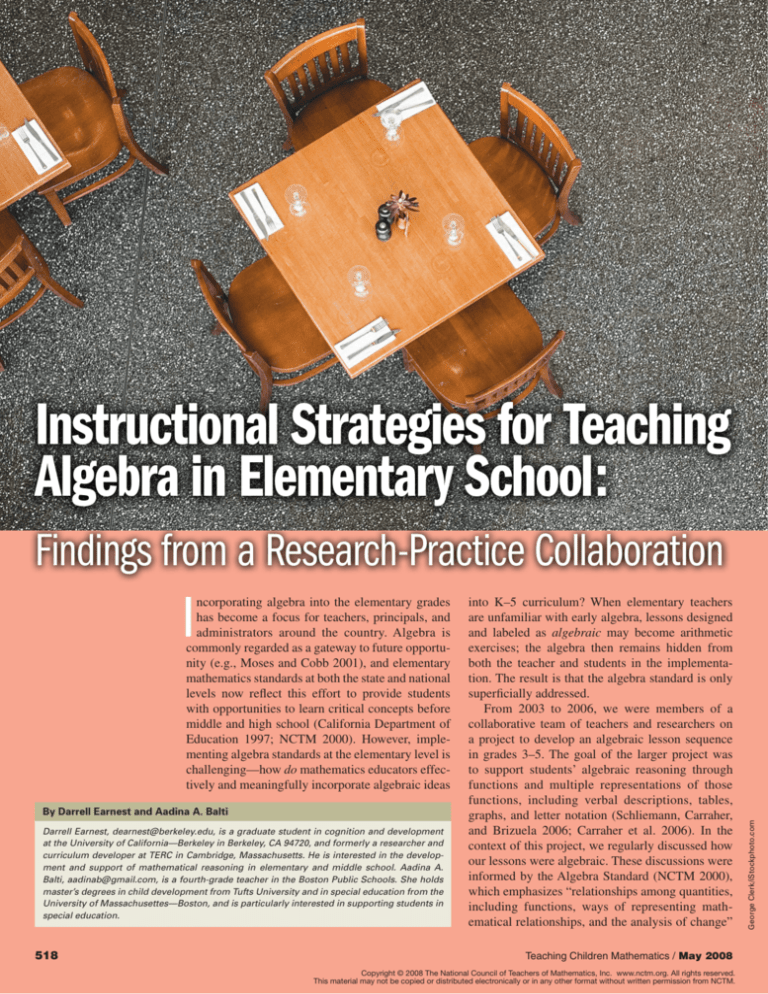
Instructional Strategies for Teaching
Algebra in Elementary School:
I
ncorporating algebra into the elementary grades
has become a focus for teachers, principals, and
administrators around the country. Algebra is
commonly regarded as a gateway to future opportunity (e.g., Moses and Cobb 2001), and elementary
mathematics standards at both the state and national
levels now reflect this effort to provide students
with opportunities to learn critical concepts before
middle and high school (California Department of
Education 1997; NCTM 2000). However, implementing algebra standards at the elementary level is
challenging—how do mathematics educators effectively and meaningfully incorporate algebraic ideas
By Darrell Earnest and Aadina A. Balti
Darrell Earnest, dearnest@berkeley.edu, is a graduate student in cognition and development
at the University of California—Berkeley in Berkeley, CA 94720, and formerly a researcher and
curriculum developer at TERC in Cambridge, Massachusetts. He is interested in the development and support of mathematical reasoning in elementary and middle school. Aadina A.
Balti, aadinab@gmail.com, is a fourth-grade teacher in the Boston Public Schools. She holds
master’s degrees in child development from Tufts University and in special education from the
University of Massachusettes—Boston, and is particularly interested in supporting students in
special education.
518
into K–5 curriculum? When elementary teachers
are unfamiliar with early algebra, lessons designed
and labeled as algebraic may become arithmetic
exercises; the algebra then remains hidden from
both the teacher and students in the implementation. The result is that the algebra standard is only
superficially addressed.
From 2003 to 2006, we were members of a
collaborative team of teachers and researchers on
a project to develop an algebraic lesson sequence
in grades 3–5. The goal of the larger project was
to support students’ algebraic reasoning through
functions and multiple representations of those
functions, including verbal descriptions, tables,
graphs, and letter notation (Schliemann, Carraher,
and Brizuela 2006; Carraher et al. 2006). In the
context of this project, we regularly discussed how
our lessons were algebraic. These discussions were
informed by the Algebra Standard (NCTM 2000),
which emphasizes “relationships among quantities,
including functions, ways of representing mathematical relationships, and the analysis of change”
Teaching Children Mathematics / May 2008
Copyright © 2008 The National Council of Teachers of Mathematics, Inc. www.nctm.org. All rights reserved.
This material may not be copied or distributed electronically or in any other format without written permission from NCTM.
George Clerk/iStockphoto.com
Findings from a Research-Practice Collaboration
(p. 37). The vision is that elementary school provides the conceptual foundation for formal algebra in middle and high school. Yet what effective
instructional strategies make algebra accessible and
meaningful to elementary students? How can we
foster algebraic reasoning in the classroom?
This article examines our experience with teaching the Dinner Tables problem in third grade, a lesson
commonly used in upper elementary grades for its
algebraic potential. The goal was to engage students
in recognizing, extending, and predicting the use of
patterns. We wanted to ensure that the lesson did not
turn into an arithmetic exercise. Using the context of
this lesson, we describe how we began to recognize
the recurring role of particular instructional strategies throughout the entire lesson sequence. When
these strategies were used, the students began to
extend and predict using mathematical patterns,
instead of completing pattern and function activities
by rote without considering the algebra involved. As
described, these strategies were the use of (1) unexecuted number expressions, (2) large numbers, and
(3) the representational context.
Three Instructional Strategies
for Early Algebra
The Dinner Tables problem was presented as follows: Students’ tasks included finding the maximum
number of people that can be seated at as many as
seven tables in both a function table and in a drawing. Students were then asked to construct a rule or
formula that uses the number of tables to determine
the number of people. The purpose of this question
was to have students consider the input-output relationship of the function. For example, a total of four
people can sit at one table; two tables will accommodate six people; three tables can accommodate
eight people; and so on (see fig. 1).
This lesson was designed to be algebraic. However, implementation can impact how algebraic
a lesson really is. For example, the lesson could
have easily turned into a problem of “adding on by
twos” when students completed a function table,
potentially rendering the lesson an arithmetic task
instead of an algebraic one. Three strategies helped
keep the algebra in the foreground of the lesson.
Using unexecuted
number expressions
An unexecuted number expression refers to a noncomputed sequence that allows for the consideration of the numbers and operations within it. For
Teaching Children Mathematics / May 2008
Figure 1
An activity sheet helped students explore the relationship between a
function table and a drawing that depicted the maximum number of
seats at the restaurant’s tables.
Dinner
Tables
Show How
1
Number of
People
4
2
3
4
example, in the case of three tables, a total of 3 + 3 +
2, or 3 × 2 + 2, people can be seated. Whereas these
expressions are equal to one value, 8, the numbers
within the expressions became a springboard for
discussion in our classroom and a tool to extend and
predict. Students said that three tables would accommodate a total of eight people, which was repeated
back to students using an unexecuted expression:
Teacher: Yeah. We can just count them. There
are three on top [the head of the table], three on
the bottom [the foot of the table]. And how many
are on the sides?
Richard: Two.
Teacher: So three and three and two is going to
give us?
Students: Eight.
Students found eight as the total value, but “three and
three and two” drew attention to the numbers within
the expression and how these numbers map onto the
drawing in figure 2. After asking a similar question
for four tables, the teacher moved to ten tables.
Instead of needing to continue from ten people and
add on by twos, students began to generalize the
idea by making use of the patterns, moving from
3 + 3 + 2 and 4 + 4 + 2 to 10 + 10 + 2, building off
the original problem context that a certain number
519
of people sit at the head and foot of the table with
two more on the sides.
Teacher: There are ten tables. How many people
will there be? Ashley, do you have a guess?
Ashley: Twenty-two.
Teacher: You think twenty-two.
Figure 2
Analyzing the drawings led to generalizing the numeric expression.
4 people
6 people
8 people
10 people
Figure 3
Photograph by Janice Gordon; all rights reserved
A break in the number sequence on the function table allowed ­students to predict values,
which demonstrated algebraic thinking.
520
Richard: Oh, that’s what I guessed!
Teacher: Can you tell me where that number
came from, Ashley?
Ashley: There will be ten on the top, then ten on
the bottom, then two on the sides.
As Ashley says that “there will be ten on the top,
then ten on the bottom, then two on the sides,” the
teacher writes this on the whiteboard both as a final
value—22—and also as an unexecuted expression—10 + 10 + 2 (see fig. 3), setting the stage for
students to extend the pattern further to predict for
100 tables and then for any number of tables.
Making the unexecuted strand of numbers
explicit provides a way to record information from a
problem and encourages students to discern emerging patterns. (Kaput and Blanton [2005] provide
an example in teacher professional development.)
Evaluating the parts of the unexecuted expression is
a powerful, strategic tool for instruction in early algebra. In the case of 3 + 3 + 2, what do these numbers
represent? In this context, what justifies a particular
operation? When considering 3 + 3 + 2 and then 4 +
4 + 2, what patterns begin to emerge? In the classroom, an expression like 3 + 3 + 2 not only retains a
connection to the original problem context but also
allows students to extend patterns to 4 + 4 + 2 or
5 + 5 + 2 to eventually predict the output for any
number of tables—an important goal of the abstraction involved in early algebra. Considering only the
final value hides important pieces of mathematics.
Using large numbers
Extending the Dinner Tables problem to include large
numbers of tables, such as 100 or 1,000, provides a
compelling reason for students to consider the relationship between the input (number of tables) and
the output (number of people) and make it abstract—
an essential piece of the algebra. One common way
to organize this information is in the form of a function table. However, a common complaint about this
particular representation is that students often move
down columns and rarely move across rows, thereby
seldom considering how a given input relates to the
corresponding output. Students frequently find the
difference from output to output as a way to fill in
missing values in the table, a task that can be more
arithmetic than algebraic, as the function table in
figure 4 shows.
Schliemann, Carraher, and Brizuela (2001)
provide a way to promote algebraic reasoning with
function tables through the use of large numbers.
In a function table, they make use of a break in the
Teaching Children Mathematics / May 2008
Figure 4
The same task can be more arithmetic than algebraic if students
move down columns instead of across rows.
Photograph by Janice Gordon; all rights reserved
sequence of inputs, as illustrated in figure 3 when
moving to ten tables. It was possible for students
to draw ten dinner tables and count the seats or to
keep adding on by twos until reaching the output
for ten tables. Drawing 100 dinner tables shows this
strategy to be inefficient and time consuming, a fact
students quickly grasped. After introducing a large
number to have students move from input to output,
the teacher had Shayne explain why he and other
students said there would be a total of 202 people.
Teacher: Can someone explain? Shayne, do you
want to quickly explain how you came up with
that number?
Shayne: Because 100 times 2 equals 200, and then
200 plus 2, and [pause] 200 plus 2 equals 202.
Shayne successfully provided a number expression
to solve for 100 that did not rely on the response for
99 tables, as some responses for 10 tables relied on
the result for 9 tables, and 8 before that, and so on.
Rather, he made a generalization to consider how to
move from the input to the output.
eacher: So, he’s saying he multiplied 100 times
T
2, which is 200, and then he added 2. Why did he
do 100 times 2? Who can explain that? Ashley?
Ashley: Because there are 100 on the top and 100
on the bottom.
By incorporating large numbers into the lessons,
we found that students sought out new patterns
and generalizations in order to answer questions
in an algebraic way. Large numbers dissuaded the
use of the arithmetic adding on strategy and at the
same time promoted algebraic reasoning about the
input-output relationship. We frequently used the
strategy of large numbers to consider the functional
relationship of input to output.
Using representational context
The term representational context refers to the
interactions and discourse constructed in a classroom around a particular representation (Ball 1993,
p. 157). Representational contexts serve as a way
to ground students’ developing mathematical ideas
and reasoning. The use of a representational context
is prevalent throughout Principles and Standards
(NCTM 2000) and in much reform curricula.
In the case of the Dinner Tables problem, thirdgrade students were able to use an algebraic expression, n × 2 + 2, to represent the problem. Does this
necessarily mean they were making connections
Teaching Children Mathematics / May 2008
about this expression related to aspects of the original drawing? What does it mean when students use
letter notation, and what is it they are representing?
After students brought up this notation in the final
class discussion, the teacher asked them what the
parts of the expression meant.
eacher: She has n times two plus two. What
T
does that stand for, Sean?
Sean: Any number!
Teacher: But any number of what?
There was a pause in the classroom as students
thought about the question. Most students had
picked up on the idea that letters could be used
to stand for any number, but now they were being
asked to apply this rule to the original context.
What is the significance of n in the Dinner Tables
problem? After a long pause, one student suggested
that n stands for the number of people; others said
that n stands for the number of tables. After some
consideration, students were able to generate a
correct response, but the question that connected
the algebraic expression to the original problem
context was not trivial.
We found that having a rich problem context
was not enough in and of itself to promote algebraic
thinking. Rather, strategic and purposeful use of
the representational context was necessary to push
students to reason algebraically and make connections across representations. By asking what the
expression n × 2 + 2 stands for, the teacher helped
make the link between the notation and the original
problem context. We found this type of question
521
essential to providing a motivation for students to
use letter notation at all.
In order to recognize when letter notation provides a useful way to represent a situation, connections such as this one across representations—in
this case, drawing tables and writing a symbolic
expression—are crucial. After establishing that n
stands for any number of tables, the teacher then
asked about the “times two,” which Alizé—who
had struggled with this idea during individual
work—now answered with confidence.
eacher: Why am I multiplying it by two? If I
T
know the number of tables, why do I need to
multiply it by two? Alizé?
Alizé: You have to multiply it by two because
when you put the tables together, the top and the
bottom have the same number of chairs.
Alizé’s explanation provides additional meaning to
the expression n × 2 + 2. Applying the rule to the
representational context is a way to help students
reach a deeper and more flexible understanding of
the algebraic expression, one essential reason to
develop algebraic reasoning with young students.
Conclusion
Incorporating algebra into an already packed
mathematics curriculum can be an elusive task,
and educators still have much to learn about how
to facilitate this implementation. Most adults
learned arithmetic and algebra as separate strands
of mathematics, with algebra kept a secret until
grade 8 or 9. Therefore, we have little personal
experience as learners to relate to our practice. Our
collaboration as a researcher and a teacher, respectively, helped us see how algebra can be successfully incorporated into the elementary classroom.
Using the instructional strategies discussed in this
article helped make the implementation of early
algebra less elusive by allowing students to see
patterns, make generalizations, and move across
representations—core goals of algebraic reasoning
in elementary school.
The Dinner Tables problem in particular is
rich with opportunities to generalize and make
abstractions. Nevertheless, these strategies can
apply to any mathematical domain and in any
classroom in which teachers are striving to push
kids to think algebraically. Although neither
author currently works with the project from
which these examples came, we each continue to
522
use these strategies in classrooms.
We encourage all elementary teachers to incorporate algebra into their mathematics classrooms.
Keep in mind that learning how to do this is a
process, one that is not always transparent. Collaboration with colleagues provides the opportunity
to share the effectiveness of instructional strategies,
compare stories of student learning, and ultimately
learn from one another. The process takes time,
but effective instruction in early algebra ultimately
creates powerful young mathematical thinkers and
provides an essential conceptual foundation for
later work in higher mathematics.
References
Ball, Deborah L. “Halves, Pieces, and Twoths: Constructing Representational Contexts in Teaching Fractions.”
In Rational Numbers: An Integration of Research,
edited by Thomas P. Carpenter, Elizabeth Fennema,
and Thomas A. Romberg, pp. 158–96. Hillsdale, NJ:
Lawrence Erlbaum Associates, 1993.
California Department of Education (DCE). Mathematics Content Standards for California Public Schools:
Kindergarten through Grade Twelve. Sacramento,
CA: CDE Press, 1997.
Carraher, David W., Analucia D. Schliemann, Barbara
M. Brizuela, and D. Earnest. “Arithmetic and Algebra­
in Early Mathematics Education.” Journal for Research in Mathematics Education 37, no. 2 (2006):
87–115.
Kaput, J. J., and M. L. Blanton. “A Teacher-Centered Approach to Algebrafying Elementary Mathematics.” In
Understanding Mathematics and Science Matters,
edited by Thomas A. Romberg, Thomas P. Carpenter,
and Fae Dremock, pp. 99–125. Mahwah, NJ: Lawrence Erlbaum Associates, 2005.
Moses, Robert P., and Charles E. Cobb. Radical Equations: Math Literacy and Civil Rights. Boston: Beacon Press, 2001.
National Council of Teachers of Mathematics (NCTM).
Principles and Standards for School Mathematics.
Reston, VA: NCTM, 2000.
Schliemann, Ananlucia D., David W. Carraher, and
­Barbara M. Brizuela. “When Tables Become Function Tables.” In Proceedings of the 25th Conference
of the International Group for the Psychology of
Mathematics Education, edited by Marja van den
Heuvel-Panhuizen, Vol. 4, pp. 145–52. Utrecht, the
Netherlands: Freudenthal Institute, 2001.
———. Bringing Out the Algebraic Character of Arithmetic: From Children’s Ideas to Classroom Practice. Hillsdale, NJ: Lawrence Erlbaum Associates,
2006. s
The project was supported by the National Science
Foundation as part of NSF-ROLE grant #0310171,
“Algebra in Early Mathematics,” awarded to D.
Carraher and A. Schliemann.
Teaching Children Mathematics / May 2008



